The wetlands of Trinidad and Tobago are inhabited by several bird species, many of which are easy to observe. This summary will highlight those common species that frequent wetlands, specifically open marsh and river environments. Mangrove dwelling species will be dealt with separately. The species listed below can also be found in habitats that mimic their traditional wetland habitat such as temporarily flooded fields and artificial ponds (including rice fields).
Striated Heron (Local name: Chuck)
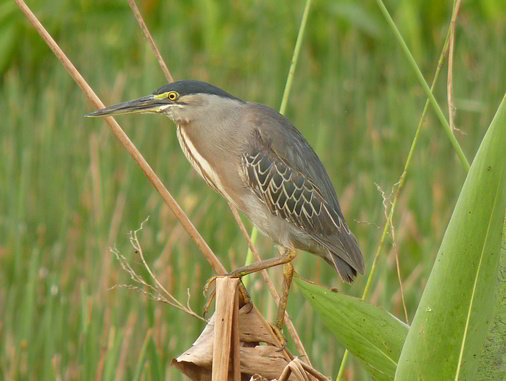
This is the commonest of the non-white herons in Trinidad. It is often seen quietly waiting to ambush its fish and insect prey from the water’s edge or atop submerged vegetation. Some birds at the Pointe a Pierre Wildfowl Trust have even learnt to use bird feed as bait for attracting fish within striking range. The Striated Heron is closely related to the Green-backed Heron and some consider the two birds to be the same species (con-specific). While common in Trinidad, the Striated Heron is replaced by the Green-backed Heron in Tobago.
Little Blue Heron (Local name: Gaulin)
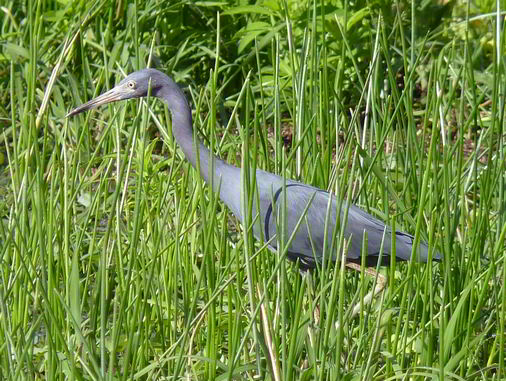
Another common member of the Heron family is the sombre looking Little Blue Heron. It is dark slate blue in colour with a slight rufous tint on its head and neck. Unlike the Striated Heron, the Little Blue Heron usually does not perch on vegetation to ambush prey, preferring to slowly stalk its food in shallow water.
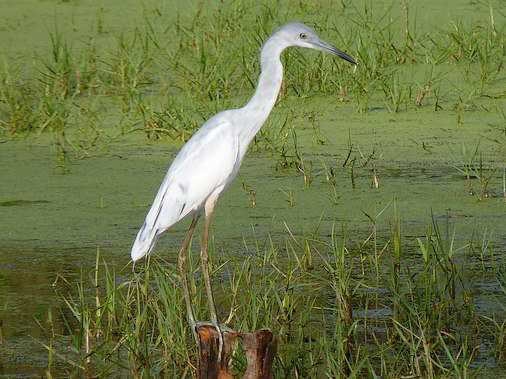
Immature birds can be mistaken for one of the white plumaged egrets but they will usually be dis-coloured with patches of grey.
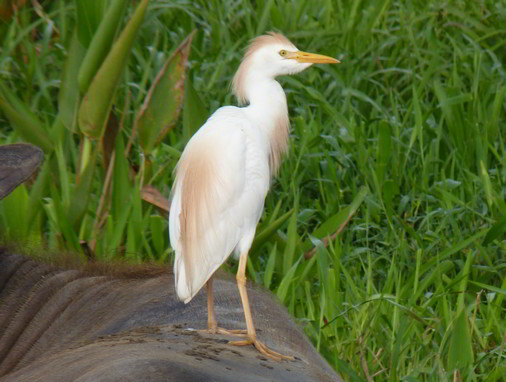
The Cattle Egret is Trinidad and Tobago’s commonest egret. They are usually seen in pastures and savannas but less often in water like other egrets. Cattle Egrets frequently follow cattle and other large animals in order to feed on the insects that are disturb by the animals. They will also follow ploughs and lawnmowers for the same reason. Cattle Egrets were originally found only in Africa and Asia but some managed to make the journey across the Atlantic Ocean to the New World and were first reported in Guiana and Suriname in 1877. By 1951 they had spread to Trinidad and by the 1960’s they had arrived in Tobago.
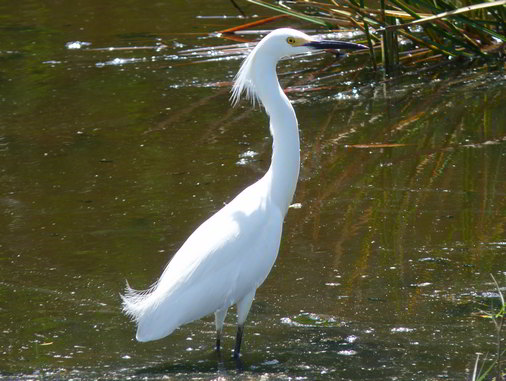
The Snowy Egret is a beautiful resident of Trinidad and Tobago wetlands. They have prominent yellow toes that contrast prominently with their black legs. Similarly, they have a contrasting yellow patch of skin (lore) around their eyes and at the base of their black bill. While feeding, snowy egrets will shuffle one foot in the water in order to disturb the small fish and invertebrates that it feeds on.
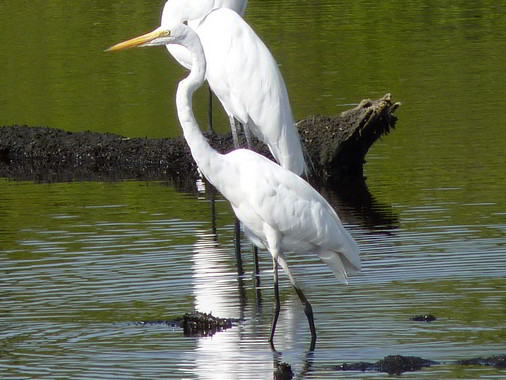
The Great Egret is the largest of our white egrets. It frequents the same area as the smaller Snowy Egret and both will sometimes associate in mixed flocks when feeding. Great Egrets are easily distinguishable by their size. They have yellow bills and black legs.
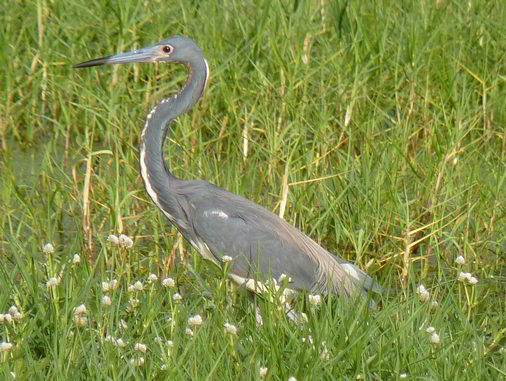
The Tricoloured Heron is an attractive member of the Heron and Egret family. They are most commonly seen in brackish water wetlands but will feed in freshwater marshes as well. They are also commonly seen feeding along the coast. Birds are slate blue with a contrasting white underside. Tricoloured Herons are very active when feeding, frantically chasing prey in shallow water.
Limpkin (Aramus guarauna)
The Limpkin is a resident of freshwater marshes in Trinidad. It is generally dark brown with white markings on its neck. In shape, it resembles an Ibis but has a relatively straight bill which is used to crack open the snails on which it feeds. When feeding, a Limpkin will pick-up a snail and take it somewhere nearby where the ground is firm. Placing the snail on the ground, it will strike the snail’s shell repeatedly until it is able to extract the flesh inside. The loud mournful call of this bird is often heard at night and gives rise to its local name of Craow.
Black-bellied Whistling Duck (Local names: Wi-chi-chi)
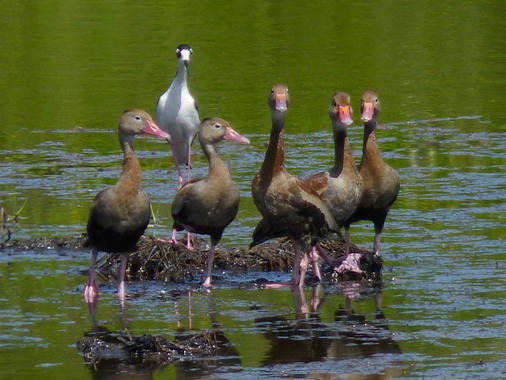
Black-bellied Whistling Ducks are our commonest resident duck species and are found in marshes on both islands. They can be identified by their black bellies and brown upperparts and their bright red bills. Black-bellied Whistling Ducks are partially nocturnal and can often be heard calling as they fly overhead at night. These ducks are frequently hunted but have been the subject of breeding and reintroduction programmes at the Pointe a Pierre Wildfowl Trust.
Yellow-chinned Spinetail
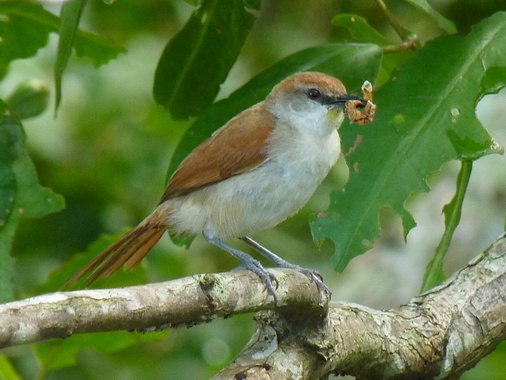
This active little bird is a common sight in marshes and other wetland environments. Its rattling call is a familiar wetland sound. The Yellow-chinned Spinetail is easily identified by its cinnamon upperparts and creamy white underparts. True to its name, it has a yellow spot just below the base of its bill. The Spinetail builds a large nest which is a favourite target for brood parasites like the Striped Cuckoo.
Yellow-hooded Blackbird (Local name: Yellow head)
Yellow-hooded Blackbird (Chrysomus icterocephalus)
Another common resident of our marshlands, the yellow-headed Blackbird is related to the well known Carib Grackle (See Garden Birds of Trinidad 1). Adult males are unmistakable with their contrasting yellow heads and black bodies. Females and immature birds have less contrasting yellow markings. They often assemble in large flocks, both when feeding and at roost.
Purple Gallinule: (Local name: Waterman)
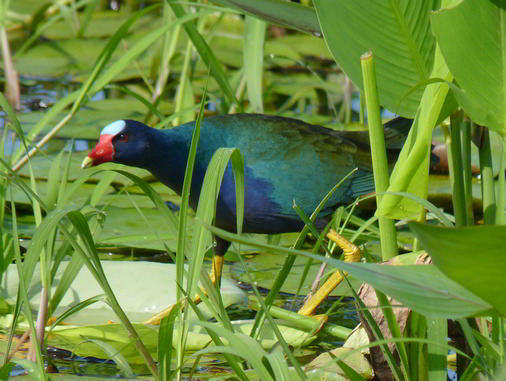
The Purple Gallinule is one of the more colourful birds to be found in Trinidad and Tobago. Resembling a small chicken, its plumage is a mixture of dark blue with greenish blue wings. It has a prominent red bill with a yellow tip. Despite being commonly hunted, it remains an abundant species in Trinidad, though less so in Tobago. It is considered to be a pest by some farmers because of its preference for grain and other vegetable crops.
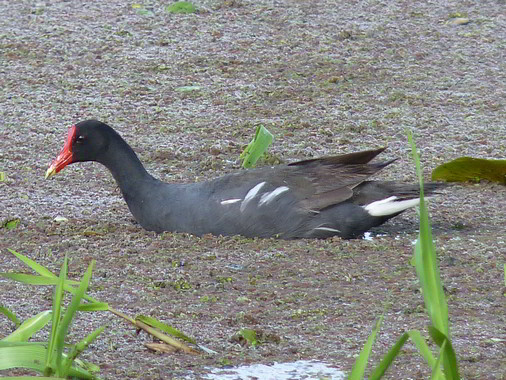
Another member of the Gallinule family, the Common Gallinule seems to prefer the clearer waterways to the dense vegetation habitat of the Purple Gallinule. It is dark gray with a prominent red frontal shield. Often seen swimming, alarmed birds will sometimes run along the surface of the water and take flight.
Wattled Jacana: (Local name: Tek-Teky or Spur-wing)
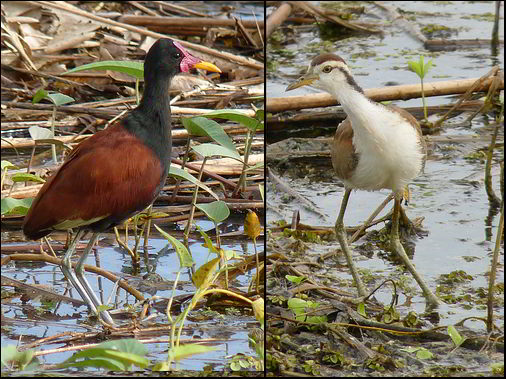
The widespread Wattled Jacana is found throughout Trinidad and Tobago (although it is less common in Tobago). It is a common inhabitant of open marsh where it can be seen walking on submerged vegetation, assisted by its long toes. Its call is a noisy rattle which has given rise to one of its local names – “Tek Teky”. Adult birds are black with rufous wings, the outer feathers of which are yellow while immature birds have cream under-parts and a dark stripe behind the eye. There is a small spur on the bend of the wing. Wattled Jacanas get their name from their red facial wattles.
Southern Lapwing (Vanellus chilenis)
This excitable member of the Plover family is often seen in dry marshland or savannas. It is easily identified by its relatively large size and bold black chest. It is even easier to identify by its raucous call which is uttered when alarmed or in flight, even at night. Despite its widespread distribution on both islands, the Southern Lapwing is a relatively recent arrival, first recorded on Trinidad in 1961 and on Tobago in 1974. It is the national bird of Uruguay.
White-headed Marsh Tyrant: Local Name: Nun
White-headed Marsh Tyrant (Arundinicola leucocephala)
This handsome wetland resident is easily identified by its white head and dark body. The coloration in male birds is very contrasting while females and immature birds have more extensive white markings throughout the body. They are often observed hunting small insects from an exposed perch (referred to as “hawking”).
Pied Water Tyrant: Local Name: Washerwoman
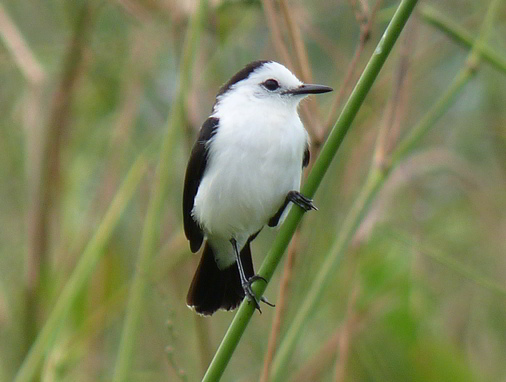
Often found in the same habitat as the previous species, the Pied Water Tyrant is identified by its white plumage which contrasts sharply with black wings and black cap. In my experience it is a more active hunter than the White-headed Marsh Tyrant, often searching for invertebrate prey in low vegetation rather than hawking from a perch.
